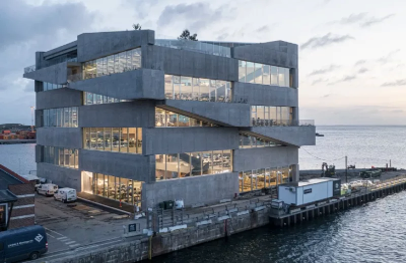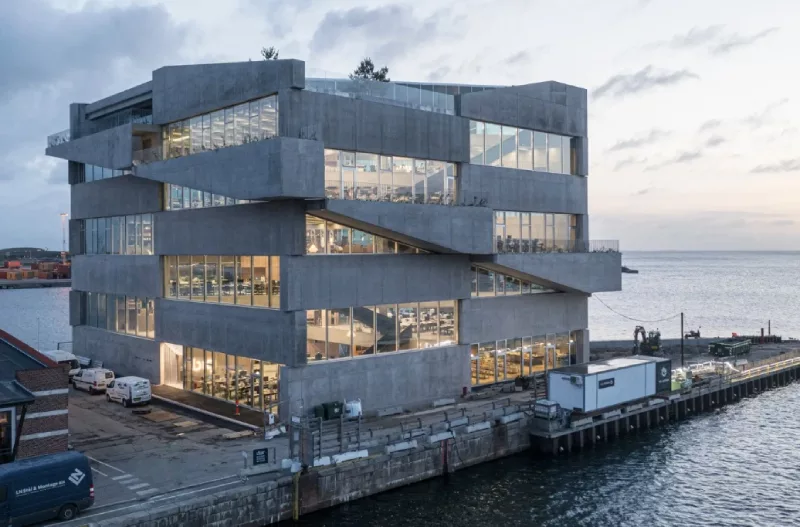6 mins read
Bjarke Ingels Group | BIG
8 mins read

Bjarke Ingels Group (BIG) Chooses RIB Solutions For New HQ Project
As one of the world’s most influential architect firms, Bjarke Ingels Group (BIG), has been working for more than 15 years to change the understanding of what architecture can and will do. On a mission to unite construction with the natural world and create a deep connection between people and nature, BIG works in close collaboration with different disciplines.
Sustainability is the key priority for BIG, working not only to solve the challenges of today, but rather to anticipate and combat the challenges of the future. Every project BIG works on is seen as an opportunity to use nature-based solutions that integrate the social and technological aspects, support communities, improve biodiversity and embrace sustainable, smarter and safer solutions. And their new HQ in Copenhagen, which aims to achieve DGNB Gold certification, is no exception. For this project, BIG took on the role of client, consultant and construction management.
Customer: Bjarke Ingels Group (BIG)
Customer type: Architect
Project type: New headquarter
Type of contract: Multi and trade
Contract
Location: Copenhagen, Denmark
Expertise: Influential and sustainable architecture
RIB products: RIB Connex, RIB Project, RIB Tender
Sustainability: DGNB gold certification
All these platforms, which are linked together, are a really good tool for contractors, because you have the whole process in one place
Michael Kepke
Bjake Ingels Group
Complete overview of the construction process with RIB solutions
The following interview was conducted in collaboration with Michael Kepke from BIG, who served as construction manager on the BIG HQ project.
“As part of the execution of our new BIG headquarters, we used RIB Project and RIB Tender to manage the documents in the tender and execution phases. We were the client, consultants and construction management, so it was important to define some internal rules in the document management solution,” explains BIG’s Michael Kepke, who served as construction manager on the BIG HQ project.
“The workspace is the consultant’s area, and when they publish files to the publication space, it’s me, as the site manager, who distributes it to the distribution space for the contractors. There was no doubt about the line between the different areas, and it was respected that I controlled everything in the publication space. In that way I also knew that all material was valid when I received it and could push it forward to the right stakeholders. It was very important for me to use the RIB structure to manage the project internally and externally, and RIB Project, coupled with RIB Tender, has been a great tool for this,” says Kepke.
Efficient document management with RIB Project
“I really like the clear separation between the workspace and the publication space in RIB Project. It is an extremely important feature for me as a consultant to be able to publish documents, when they are approved. Once I have published the documents I take responsibility for its validity. This is a fundamental function that RIB has always had and that I have always use – because it is the best way to manage the project and the project material. Situations and errors can arise where you have to find out where the responsibility lies; maybe a drawing is missing, maybe the wrong drawing has been used, and regardless of the problem, we have been able to quickly find a solution and easily find out who is responsible in the specific situation,” continues Kepke.
RIB Project keeps track of the audit trail and contractual obligations

Version sets within RIB Project serve as crucial documentation for phases, contracts, and related matters. They become particularly invaluable in the event of conflicts, especially concerning financial aspects of a project.
“For me, it’s incredibly important to save version sets on a construction project, also on RIB’s platform, so we can always access the audit trail of a project. Even if everything goes well and we reach the finish line, it’s inevitable that we have to go back to the contractual responsibilities and understand what the original terms were. There are always some shortcomings, and during construction projects there are always situations where we need to go back. And here, a constructive dialog about finances or conflicts is essential for a good collaboration now and in the future,” explains Kepke.
RIB Connex facilitates effective communication and coordination
“We used RIB Connex to manage RFI’s, NCR’s, inspections and quality assurance for our 2 multi-trade contractors and 14 trade contractors. With RIB Connex, you can easily create a complete overview of the project’s tasks, as well as an overview of the individual contracts. With the mobile app, you can quickly create and distribute tasks either on site or at the office. I really like the communication channels in RIB Connex because it is very structured,” says Kepke.
Communication channels in RIB Connex are designed to optimize communication and workflows between project stakeholders with tailored user permissions to the relevant channels. This creates a framework for effective collaboration and ensures that everyone can access the right information at the right time. A key benefit of these channels is their flexibility, allowing for adaptation to company standards or project needs.
“In the beginning, I was possibly a bit too rigid because I wanted all communication to go through me as client. Later on, I opened up more so that people could ask each other questions, but I don’t think it should be too open, otherwise it can be hard to keep up. I’ve taken different approach than others who make big organizational charts and use different communication methods. I’ve divided the channels into contracts and then inspections had its own channel”, remarks Kepke.
“It’s just easier to manage this way and it’s also much easier to filter without a huge organization chart. Communication channels make it more efficient to manage because you can communicate exclusively and directly with the responsible project participants. It was also extremely helpful to be able to attach inspection and deviation reports to the construction meeting minutes, leaving no unanswered questions at the next meeting. It meant that everyone knew exactly which tasks were active and required answers. This was a great feature that we used frequently to get the overview exported in real-time,” concludes Kepke.
Efficient project management with digital solutions

“All these platforms, which are linked together, are a really good tool for contractors, because you have the whole process in one place. When everything is linked together, I have the entire audit trail of the project in one platform, and it makes it much easier later on, especially now at handover of the project: What tender documents did we have, what drawings did we have, are there any unanswered inspection notes or anything else I need to handle – in other words, I have all the information I need to complete the handover, in one platform.
RIB support, R&D and consultants have been instrumental in the digital success of the project, and have helped to create good processes and structures in the various applications for the client, consultants, and contractors,” concludes Michael Kepke.
Most Recent
6 mins read
9 mins read
6 mins read
6 mins read
Case Study Categories

Ebook


